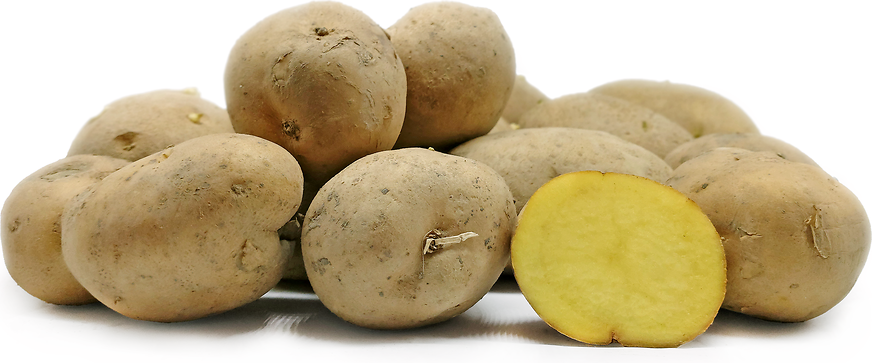


Sante Potatoes
Estimated Inventory, 1 Lb : 0
Description/Taste
Sante potatoes widely range in size from small to large, depending on growing conditions, and generally have a short, oval to oblong, uniform shape. The skin is semi-thick, smooth, and yellow, bearing many shallow eyes. The skin is also often covered in a coating of dried soil, giving the tubers a light brown appearance. Underneath the surface, the flesh is golden yellow and dense, containing a low starch and high dry matter content. Sante potatoes are considered a universal variety, encompassing textural qualities of both floury and starchy potatoes. When cooked, the tubers have a subtly sweet, earthy, and mild flavor with a soft but firm, fluffy consistency.
Seasons/Availability
Sante potatoes are available year-round.
Current Facts
Sante potatoes, botanically classified as Solanum tuberosum, are a multi-purpose Dutch variety belonging to the Solanaceae or nightshade family. The yellow tubers are a medium-early cultivar created to showcase improved resistance to disease, extended storage capabilities, and high yields. The tubers are ready for harvest approximately 80 to 90 days after planting and were selectively bred to grow in compact spaces. Sante potatoes are also highly favored for their mild, earthy taste and balanced, floury, and starchy texture, allowing the tuber to be utilized in a wide variety of culinary preparations. In Europe, the variety is a choice potato for processing and is heavily used in restaurants. Sante potatoes are also planted in home gardens, especially in Russia, valued for their easy-to-grow and hardy nature.
Nutritional Value
Sante potatoes are an excellent source of vitamin C to strengthen the immune system while reducing inflammation and provide potassium to balance fluid levels within the body. The potatoes are also a source of calcium and phosphorus to protect bones and teeth, magnesium to maintain healthy nerve functioning, and lower amounts of vitamin B6, vitamin A, zinc, iron, and selenium.
Applications
Sante potatoes are considered an all-purpose variety, utilized for boiling, chipping, roasting, and baking. The tuber’s flesh does not oxidize quickly, allowing the potato to be commercially processed without the concern that the flesh may darken. Sante potatoes are commonly boiled and served with spices as a filling side dish, cubed and stirred into soups, curries, and stews, or cooked and tossed into salads. The potatoes can also be sliced and layered into casseroles, shepherd’s pie, and gratins, shredded into hash browns and potato cakes, stuffed and baked, or wedged and roasted to develop a crisp exterior and fluffy interior. In Europe, Sante potatoes are popularly sliced and used to make French fries. Sante potatoes pair well with herbs such as parsley, cilantro, dill, rosemary, and thyme, chives, leeks, garlic, ginger, meats including beef, pork, poultry, and fish, mushrooms, eggplant, squash, green beans, bell peppers, and cheeses such as cheddar, parmesan, blue, gruyere, and mozzarella. Whole, unwashed Sante potatoes will keep 3 to 5 weeks when stored in a cool, dry, and dark location away from direct sunlight.
Ethnic/Cultural Info
Sante potatoes were a favored cultivar commercially grown for industrial processing in Belgium. The multi-purpose spud is traditionally utilized for fries, a specialty dish deeply rooted in Belgian gastronomy and culture. Belgians are believed to consume more fries per capita than any other European country. The country’s residents fondly recall fritkots lining the city streets or vendors who sell warm fries wrapped in a cone shape, drizzled in mayonnaise. There is much debate surrounding the origins of slender, fried potatoes, with many experts tracing the dish back to either Belgium or France. When potatoes were first brought to Europe from the New World with returning Spanish explorers in the 15th and 16th centuries, the tubers were introduced to Belgium early on due to the Spanish controlling most of Belgium at the time. Among Belgian legends, once potatoes were introduced, the tubers were fried during the winter as a food source for small fishing villages in the Meuse Valley. The villagers primarily lived off fried fish, but when the rivers would freeze over in the winter, they turned to frying potatoes sometime around the late 17th century. Later during World War I in the early 20th century, Belgian soldiers who spoke French offered American soldiers fried potatoes. Assuming the soldiers were of French nationality, the Americans coined the term French fry for the fried potatoes, which has remained the primary descriptor for the dish in the United States. Despite other claims by the French for ownership over the French fry’s creation, Belgian residents have been petitioning for UNESCO to establish fried potatoes as a symbol of Belgian gastronomy. In Bruges, Belgium, there is even a museum dedicated solely to fries. The museum features several floors filled with the history of the fry, traditional preparation methods, and an opportunity to sample fries prepared in the preferred Belgian style, the double fry method.
Geography/History
Sante potatoes were created in Veendam, the Netherlands, in 1971 through Agrico, a cooperative of over 1,300 potato breeders and farmers. Agrico has developed an extensive network to provide consumer-friendly tubers and seed potatoes for expanded potato cultivation worldwide. The variety was developed by breeder J. Vegter and is a cross between potato varieties SVP AM 66-42 and SVP Y 66-13-636. Sante potatoes were released for cultivation throughout Europe and saw commercial success in many different countries. The variety was registered as an accepted cultivar in Russia in 1993, and later in 1997, Sante potatoes were registered with the Canadian government. Today Sante potatoes are grown through commercial farms and home gardens in Europe, Asia, and North America. Once harvested, the tubers can be found fresh through specialty distributors or local markets, but the potatoes are also commonly sent straight to processing for canned goods and restaurant purposes.




